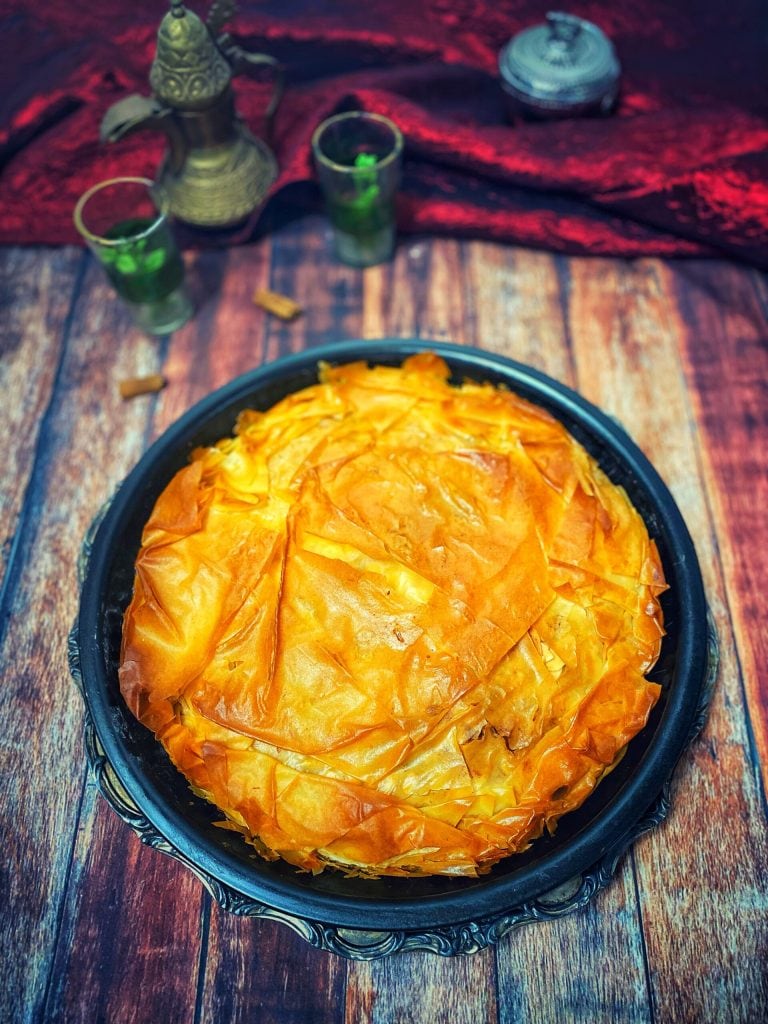The Pastilla is a meat or seafood pie from Maghreb cuisine made with warqa dough, similar to phyllo dough.
It is a specialty of Morocco, Algeria, and Tunisia, where its variant is known as malsouka.
More recently, it has been spread by emigrants in France, Israel, and North America.
The chicken pastilla was traditionally made with pigeons (squab), but today shredded chicken is used more frequently.
It combines sweet and savory flavors; crispy layers of werqa, flavorful meat slowly cooked in broth and spices then shredded, and a crunchy layer of toasted and ground almonds, cinnamon, and powdered sugar.
In Morocco, pastilla is generally served as an appetizer at the beginning of special meals and in one of two forms: with poultry or with seafood.
In Algeria, it is usually made with chicken or pigeon.

- Difficulty: Medium
- Cost: Economical
- Preparation time: 10 Minutes
- Portions: 6 People
- Cooking methods: Stove, Oven
- Cuisine: Moroccan
- Seasonality: All seasons
Ingredients
- 5 sheets warqa dough (or phyllo dough)
- 1.65 lbs chicken
- 2 onions
- 1 packet saffron
- to taste ground ginger
- 2 cups meat broth
- 2.6 oz almonds
- 3.5 oz butter
- to taste powdered sugar
- to taste ground cinnamon
Tools
- 1 Baking Pan 11-inch
Steps
Cook the chicken in the broth (2 cups broth and 2 cups water) with the onions and spices for 45 minutes.
Remove from the broth, cool, and shred.
Thicken the broth for 20 minutes after adding the eggs.
Blanch the almonds, toast and grind them, add the cinnamon and powdered sugar.
In an 11-inch round baking pan, create layers with warqa (or phyllo) dough by brushing each sheet with melted butter:
base layer of dough, add the cream created from the thickened broth, cover with a layer of dough, add the chicken, another layer of dough, finish with the almond mix, and top with the last 2 sheets of dough.
Bake in a ventilated oven for 30 minutes at 350°F.
Dust with powdered sugar and cinnamon before serving hot.

FAQ (Questions and Answers)
What are the variants of Pastilla?
The seafood pastilla (in Moroccan Arabic: بسطيلة الحوت, romanized: basṭīlat el-ḥūt) usually contains fish and other seafood, as well as shaʿīriyya (a type of wheat vermicelli).
Unlike chicken pastilla, it is not sweet but spicy.
It is usually topped with a light sprinkle of grated cheese and some lemon slices.
This version is often served at Moroccan weddings.
In traditional Fassi cuisine, pastilla can also be served as a dessert and is called Jowhara (جوهرة, jewel) or “Pastilla with milk.”
This is also made of warqa and a milk cream.
The Jowhara is flavored with orange blossom water and decorated with cinnamon and sugar.
Among Moroccan Jews, pastilla is prepared with olive oil or margarine instead of butter, to adhere to kashrut laws which prohibit the consumption of dairy and meat together.
In Moroccan Jewish cuisine from Casablanca, it includes caramelized onions in the filling.
Modern Israeli adaptations sometimes use phyllo sheets and shape the dish into cigars.
An increasingly popular variation involves preparing individual pastries instead of large pies.What is warqa dough?
Malsouka (Arabic: ملسوقة, also malsouqa) or warqa (Arabic: ورقة), also known as brik sheets (Arabic: ورق البريك, French: feuilles de brick) or bourek sheets (ورق البوراك) or dioul (Arabic: ديول), is a Maghreb pastry sheet that resembles phyllo.
It is thicker than phyllo and unlike it, is made by spreading thin layers of batter on a heated pan rather than rolling out a raw dough.
There are many uses for the dough, including malsouka tagine, pastilla, samsa (a typical sweet of Algerian and Tunisian cuisine consisting of several layers of pastry similar to puff pastry and filled with chopped almonds and sesame seeds, then fried or baked), brik (the North African version of burek), and baklava.

